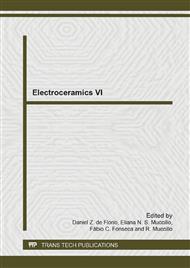[1]
J. Mannhart, D. G. Schlom, Oxide interfaces - An opportunity for electronics, Science 327 (2010) 1607.
DOI: 10.1126/science.1181862
Google Scholar
[2]
H. Y. Hwang, Y. Iwasa, M. Kawasaki, B. Keimer, N. Nagaosa, Y. Tokura Emergent phenomena at oxide interface, Nature Mater. 11 (2012) 103.
DOI: 10.1038/nmat3223
Google Scholar
[3]
S. A. Fedoseev, A. V. Pan, S. Rubanov, I. A. Golovchanskiy, O. V. Shcherbakova, Large, controllable spikes of magnetoresistance in LCMO/STO superlattices, ACS Nano 7(2013) 286.
DOI: 10.1021/nn304127n
Google Scholar
[4]
O. Morán, F. Perez, W. Saldarriaga, K. Gross, E. Baca, Magnetic anisotropic behaviour in epitaxial LCMO/YBCO/LCMO and LCMO/LCMO/YBCO trilayered structures, J Appl Phys 103 (2008) 07F724.
DOI: 10.1063/1.2837875
Google Scholar
[5]
V. K. Malik, I. Marozau, S. Das, B. Doggett, D. K. Satapathy, M. A. Uribe-Laverde, N. Biskup, M. Varela, C. W. Schneider, C. Marcelot, J. Stahn, C. Bernhard Pulsed laser deposition growth of heteroepitaxial YBCO/LCMO superlattices on NGO and SLATO substrates, Phys Rev B 85 (2012).
Google Scholar
[6]
Z. L. Zhang, U. Kaiser, S. Soltan, H. -U. Habermeier, B. Keimer Magnetic properties and atomic structure of LCMO-YBCO heterointerfaces, Appl Phys Lett 95 (2009) 242505.
DOI: 10.1063/1.3274044
Google Scholar
[7]
A. V. Pan, S. Pysarenko, S.X. Dou Drastic improvement of structure and current-carrying ability in YBCO films by introducing multilayered structure, Appl Phys Lett 88 (2006) 232506.
DOI: 10.1063/1.2211051
Google Scholar
[8]
A. V. Pan, S.V. Pysarenko, D. Wexler, S. Rubanov, S.X. Dou Multilayering and Ag-doping for properties and performance enhancement in YBCO films, IEEE Trans. Appl. Supercond. 17 (2007) 3585.
DOI: 10.1109/tasc.2007.899033
Google Scholar
[9]
V. Peña, N. Nemes, J. Garcia-Barriocanal, Z. Sefrioui, C. Leon, S.G.E. Te Velthuis, A. Hoffmann, M. Garcia-Hernandez, J.L. Martinez, J. Santamaria Large magnetoresistance at oxide LCMO and YBCO interfaces, Phys Rev B 69 (2004) 224502.
DOI: 10.1557/proc-0887-q11-02
Google Scholar
[10]
G. Deutscher; F. Meunier Coupling Between Ferromagnetic Layers Through a Superconductor , Phys Rev Lett 22 (1969) 395.
DOI: 10.1103/physrevlett.22.395
Google Scholar
[11]
S. Soltan; J. Albrecht; H. -U. Habermeier; Ferromagnetic/superconducting bilayer structure: A model system for spin diffusion length estimation , Phys Rev B 70 (2004) 144517.
DOI: 10.1103/physrevb.70.144517
Google Scholar
[12]
D.A. Luzhbin; A.V. Pan; V.A. Komashko, V.S. Flis, V.M. Pan, S.X. Dou, P. Esquinazi Origin of paramagnetic magnetization in field-cooled YBCO films, Phys. Rev. B. 69(2004) 024506.
Google Scholar


